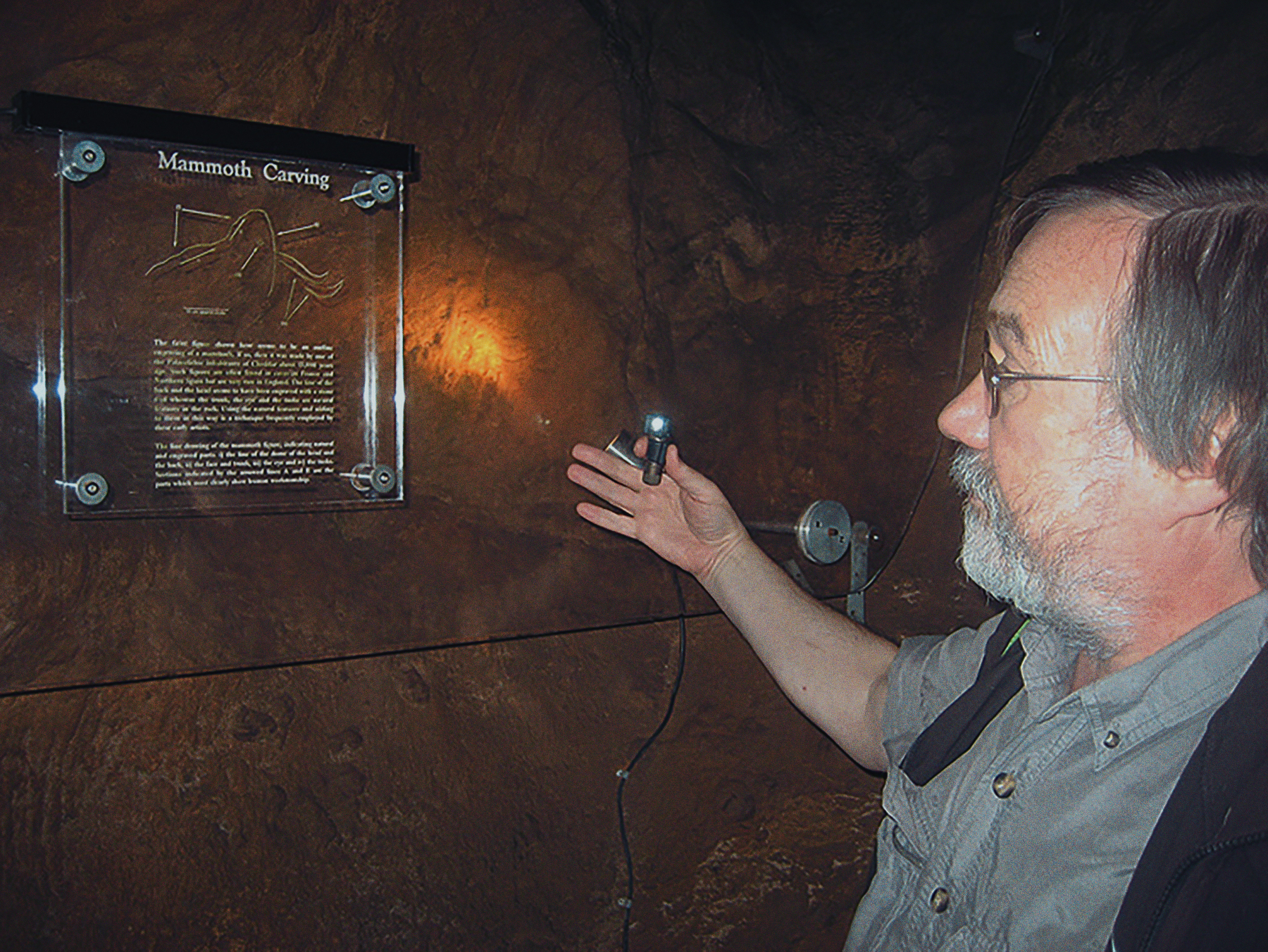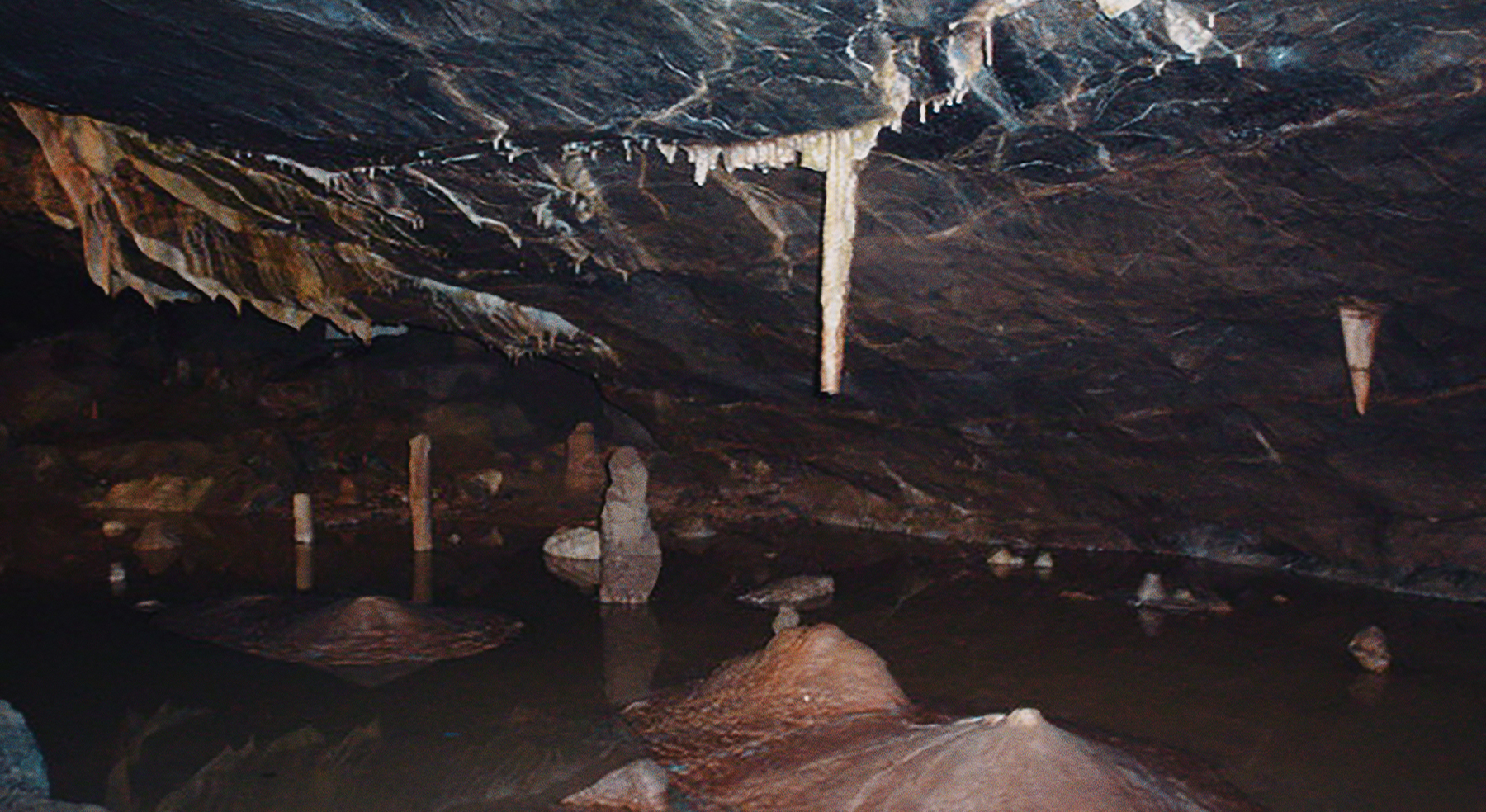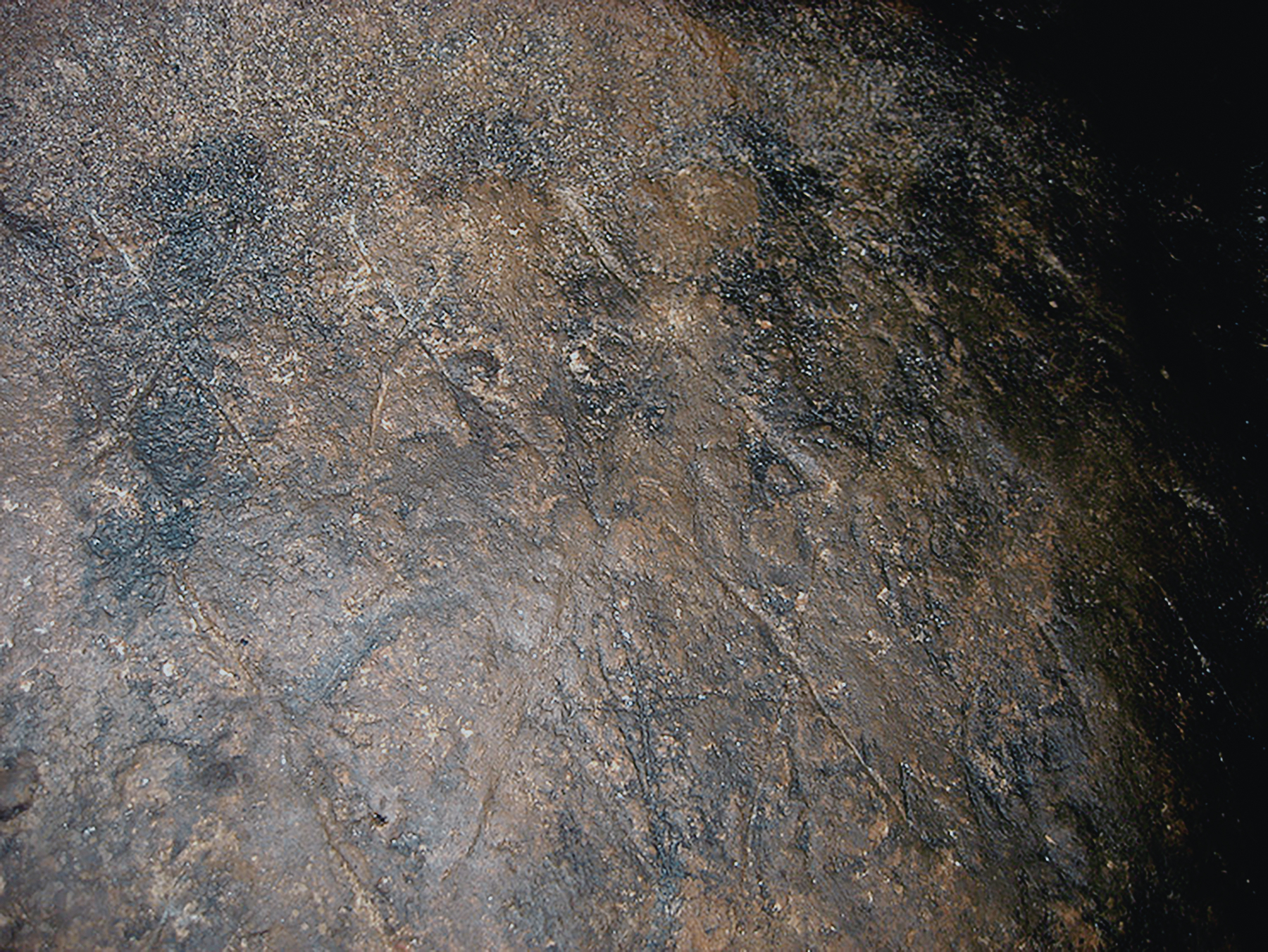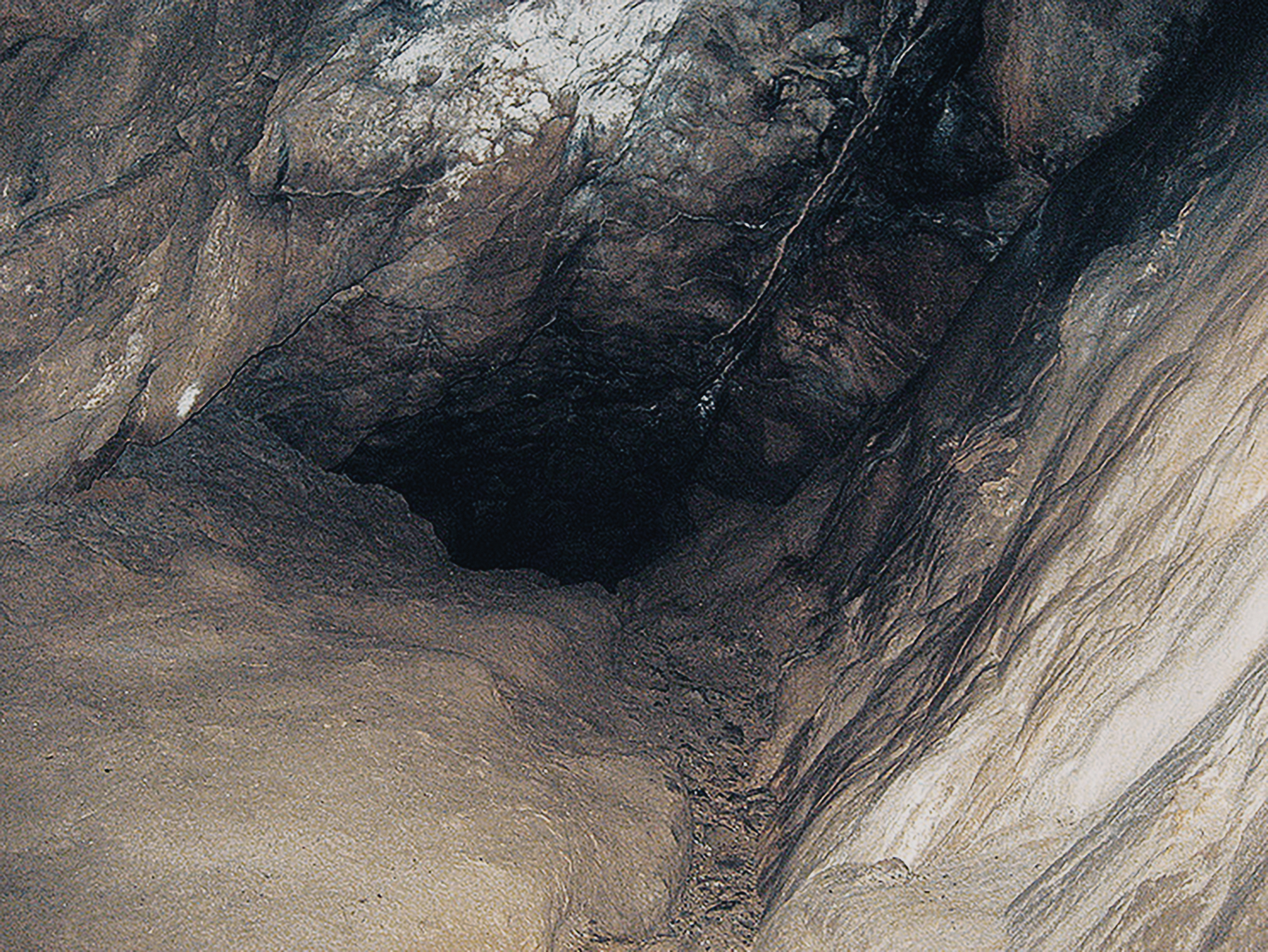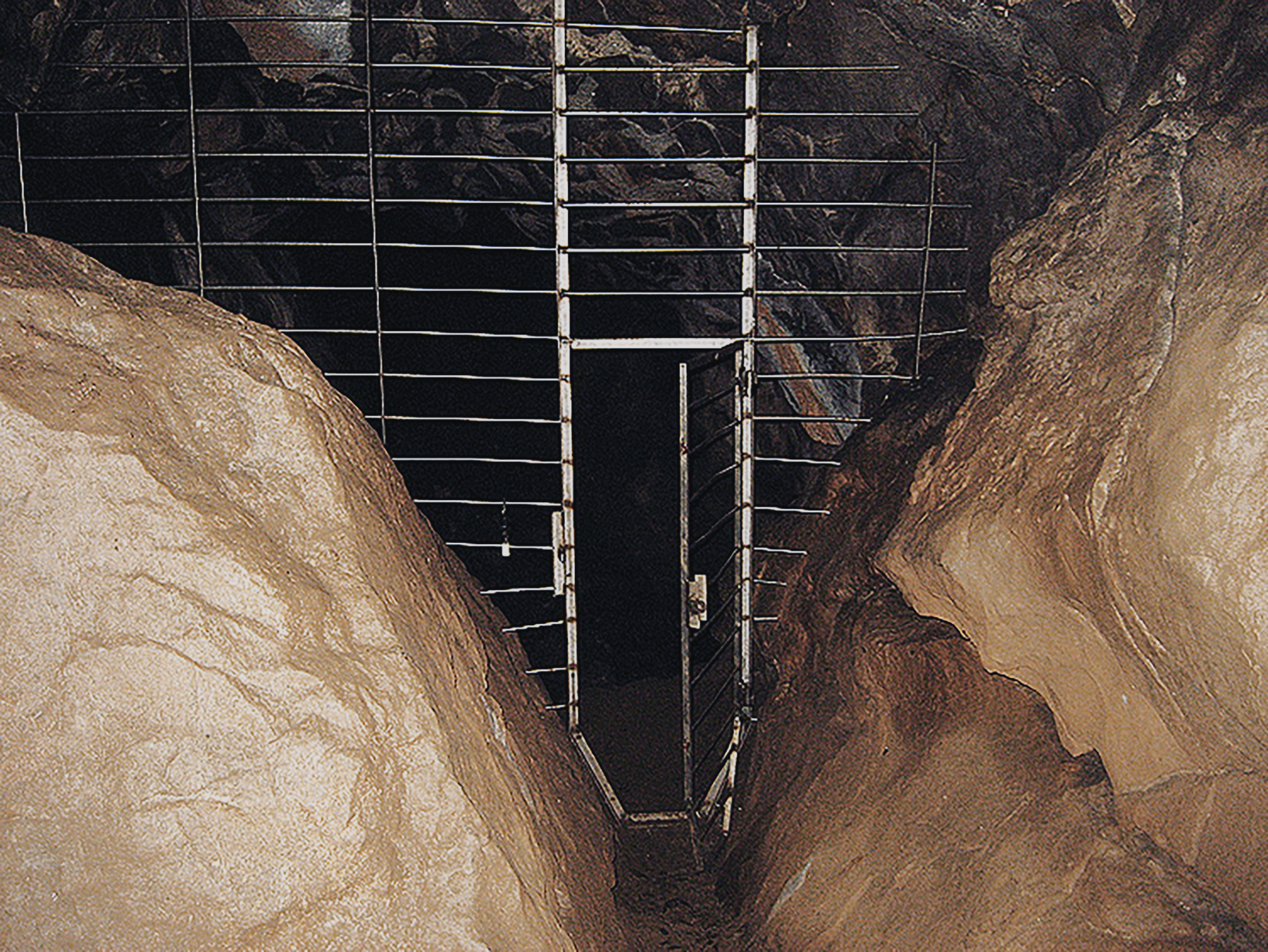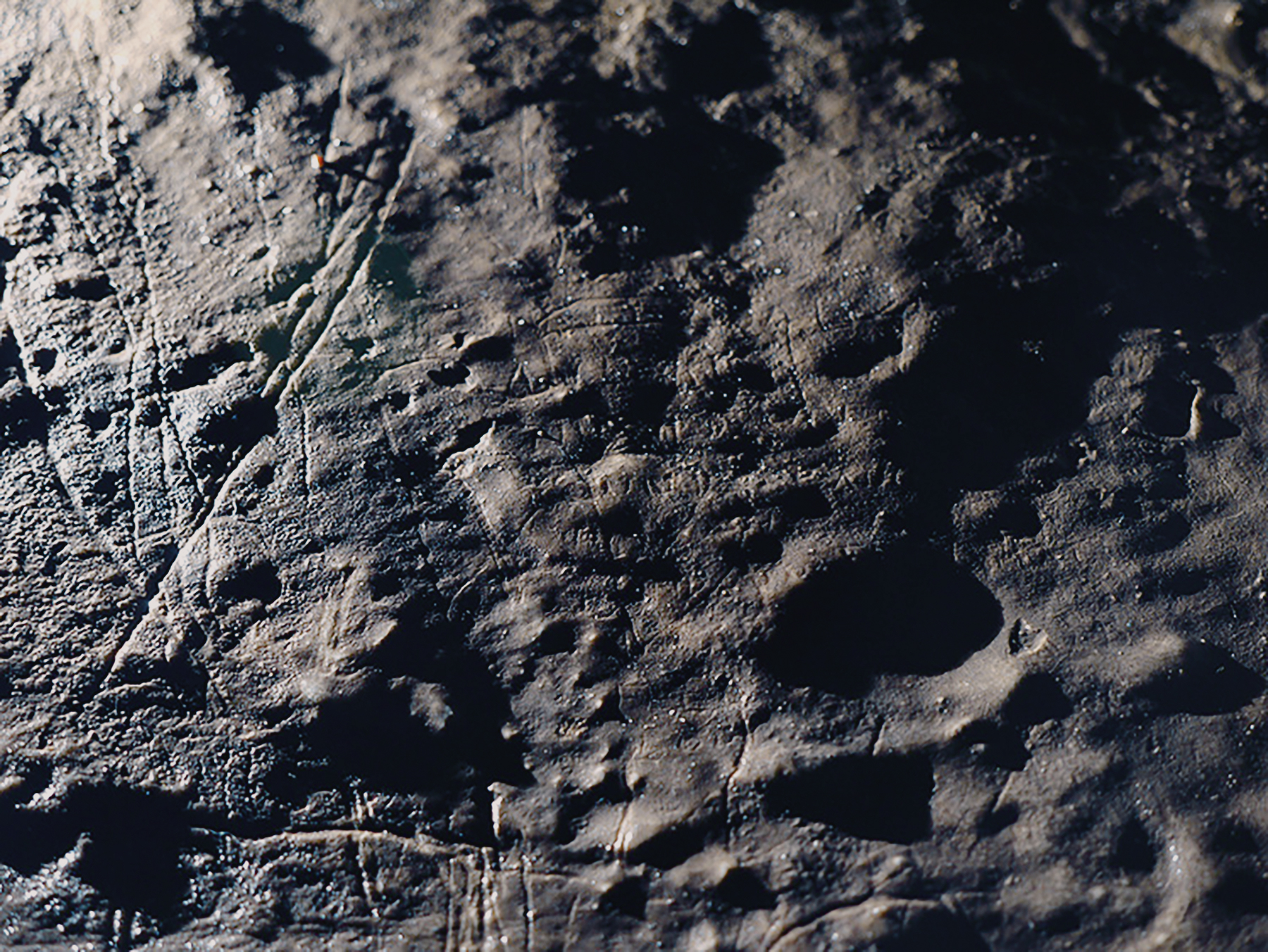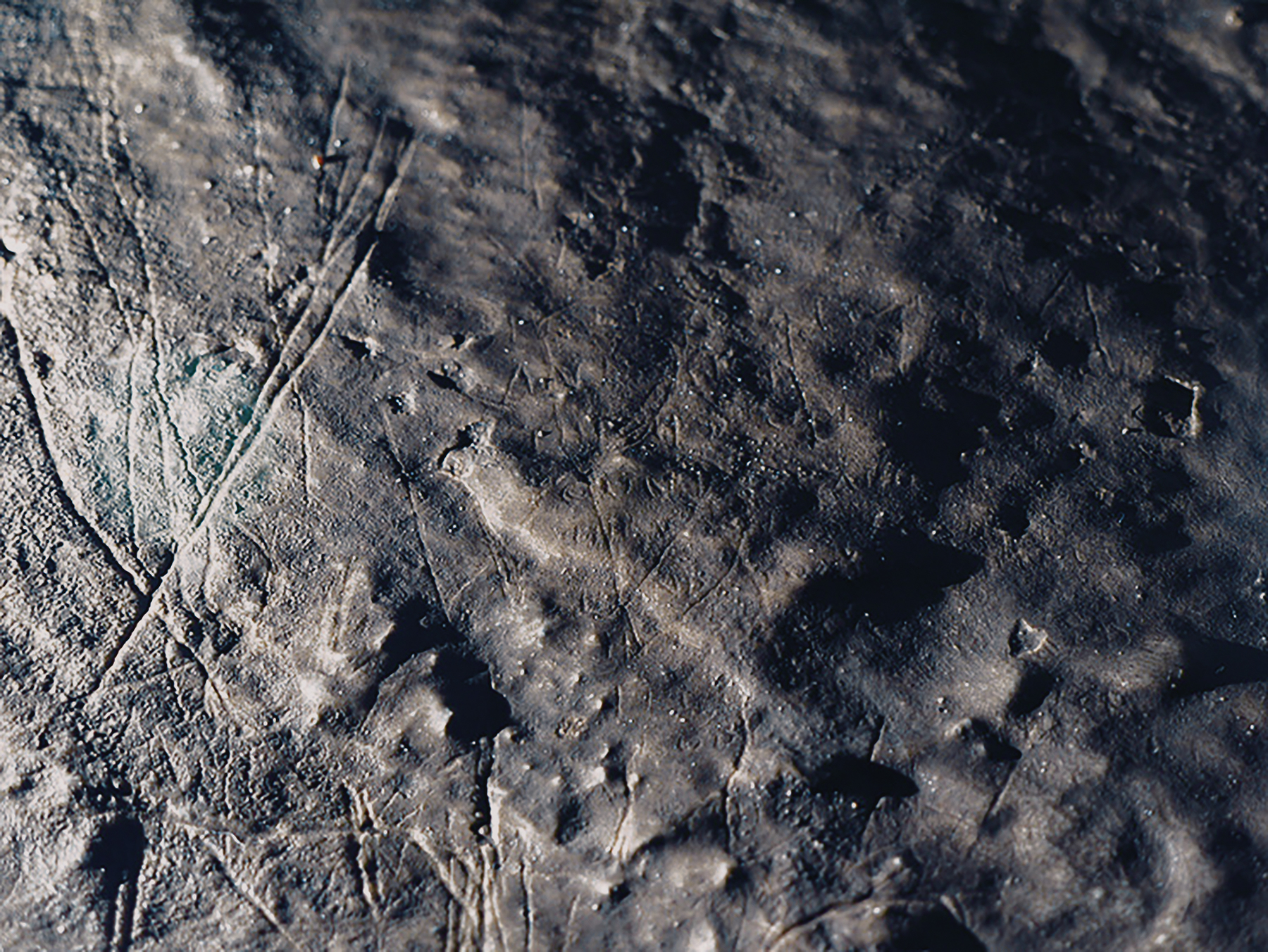


This section of the Bradshaw Foundation - British Isles Prehistory Archive is based on the research of Graham Mullan & Linda Wilson, of the University of Bristol Spelaeological Society. They have spent several years minutely examining and mapping numerous caves in the Mendip Hills. This section will focus on their discoveries within three caves in particular; Gough's Cave, Aveline's Hole and Long Hole.
Cro-Magnons - the first anatomically modern humans - are believed to have arrived in Europe about 40,000 years ago. Evidence of occupation in the British Isles can be found with the skeletal remains of the 'Red Lady of Paviland' dated to 29,000 years ago, belonging to the Aurignacian culture. During the following Ice Age, known as the Last Glacial Maximum (LGM)) around 20,000 years ago, Northern Europe may have been completely depopulated of humans. Humans probably returned to the region now known as the British Isles approximately 15,000 years ago as the ice retreated, initially as bands of hunter-gatherer communities during the summer months.
The Mendip Hills - a range of limestone hills to the south of Bristol and Bath in Somerset - have numerous recorded prehistoric sites; Palaeolithic, Mesolithic, Neolithic, Iron Age, and Bronze Age. The Cheddar Man, Britain's oldest complete skeleton, was found in Gough's Cave, part of the Cheddar Complex.
This section is based on two articles authored by Graham Mullan & Linda Wilson [#44 & #49] appearing in the International Newsletter on Rock Art - INORA, edited by Dr Jean Clottes under the auspices of Comite International d'Art Rupestre [CAR - ICOMOS], Union Internationale des Sciences Prehistoriques - Protohistoriques [UISPP] and Association pour le Rayonnement de l'Art Parietal Europeen [ARAPE].
To read more about rock art from the British Isles click here.

Much of the rock surface in this cave has been modified since it was opened to the public by Richard Gough in the 1890s. However, during a careful search of the remaining original surfaces by the authors the image shown in Fig. 2 was noted on 22 June 2003. It is located in a small alcove on the south side of the show cave between the Fonts and the blasted section of passage that indicates the end of the cave as known in prehistoric times.
This can be seen most clearly on the back of the head and in the middle of the line of the back. The remainder of the line of the back and the dome of the head, although clearly a single feature, is faint and partially infilled with sediment which obscures its character. However the cave, including the area in which the figure is located, has been subject to repeated flooding which will have had a direct effect on the preservation of the rock surface. A line of this shape and type is not replicated elsewhere on the rock wall, either in direction or in texture. It does not follow the grain of the rock and has a distinctive appearance from the obvious natural lines on the alcove wall. Certainly there is no line which either takes the same direction or shows similar changes of direction to this one.
What may be engraved lines appear to complement natural features in the rock surface which insinuate the trunk and possibly also the tusks of the mammoth. The latter parts have a higher relief than the rest of the figure and seem to be in keeping with the texture of the remainder of the rock surface in this alcove. Similarly the 'eye' appears to be a natural feature. The incorporation of natural features in an engraving to create animal depictions is a well attested phenomenon in Palaeolithic art. Given the still somewhat controversial nature of the Creswell finds (Bednarik 2005; Ripoll et al. 2005) we approached the authentication of this find with a great degree of care. The find was carefully recorded, by photography, laser scanning and drawing, and a careful study undertaken of how natural processes acting in the cave might have affected the rock surface. Details of this work can be found in Mullan et al. 2007. We also sought the opinion of Jill Cook of the British Museum, who gave her backing to the view that the line of the back and head of the figure were reasonably likely to have been made in antiquity using a stone blade.

The last mammoths in England disappeared around 12,000 years BP. Whether there were any in southern England at any point during the Last Glacial Interstadial is unknown, but there are well dated mammoths from as close as Shropshire at this time (Coope & Lister 1987). It is also the case that artefacts of mammoth ivory have been found at Cheddar (Currant et al. 1989) as well as at other cave sites, Kent's Cavern, King Arthur's Cave, and Pin Hole, from which lithics of similar, Creswellian, types are known (Jacobi 2004). A double-bevelled ivory rod from Gough's Cave has been directly dated. This is: OxA-1890: 12,170 ± 130 BP (Hedges et al. 1990). It is therefore clear that the LUP inhabitants of Cheddar would have been familiar with mammoths.
Paintings and engravings of mammoths are known from numerous sites in France. Probably the best known collection, and certainly the most comprehensive, is that from the Grotte de Rouffignac, where 154 of the approximately 300 known Palaeolithic images of mammoths can be found (Plassard 1999). The artwork in this cave was recorded and comprehensively studied by Barriëre (1982). He gives (p. 175) a table showing the various different styles of tusk to be found there together with sufficient illustrations to show that, in stylistic terms, Palaeolithic depictions of mammoths can vary from the highly detailed to extremely simple, almost caricature, twin-humped lines. These latter are, however, easily recognisable with very little experience. Whilst it is the case that many examples of Palaeolithic art are highly detailed and true to life, many are deliberate caricatures. The apparent mammoth depiction in Gough's Cave would fit comfortably within the corpus of work known from Rouffignac and from the Palaeolithic as a whole.
Photographic and laser recordings seem to support the observation that the engraved lines visible on the alcove wall may constitute deliberate drawing. No similar markings have been seen on the walls of this cave. Some parts of the figure are clearly natural in origin but the line of the head and the back show features consistent with it having been engraved with a stone tool. These have been partially obscured by the presence of the figure in a part of the cave that has been subject to repeated flooding. The figure appears to be that of a mammoth. Such an interpretation is consistent with a Late Upper Palaeolithic origin.
There is thus a possibility that this represents a genuine example of Late Upper Palaeolithic cave art, the first such to be noted in Southern England.
In 2004, no reliably attested ancient cave art had been found anywhere in England. Many people, ourselves included, had argued that it was highly unlikely any would be found. However, the discoveries by Bahn, Ripoll and Pettitt (Bahn et al. 2003), whilst still the subject of some controversy (Bednarik, 2005; Ripoll et al., 2005), provided the necessary catalyst for new investigations and led directly to the discoveries outlined here.
We are fortunate to live near the Mendip Hills, an area rich in Palaeolithic and Mesolithic archaeology, most of which has been discovered in caves including those at Cheddar, where rich Creswellian deposits have been excavated over the years. We therefore decided to put the experience we have gained over the last 15 years in the study of the French caves into practice.
On 6th July 2003 we visited Aveline's Hole, Burrington Combe, and spent several hours examining the walls, with the aid of LED lights. At that time, we were searching for representational art and the site contained nothing which could fall into that category. We did, however, notice and photograph a series of engraved lines, which were quite different in appearance from the modern graffiti on various parts of the cave walls.
Shortly afterwards, whilst reporting on the progress of the project to Dr. Roger Jacobi of the British Museum, we mentioned the engraved lines and their appearance of age and were surprised at the interest they generated in him. He drew our attention to a number of parallels in the French Mesolithic record and also other examples of simple geometric designs from the same period (see, especially, Hinout & Angelier 1968 and Tassé 1982). We therefore undertook a process of attempted verification, which included site visits from Roger Jacobi; Jill Cook, also of the British Museum; George Nash, who has studied Mesolithic rock art in Scandinavia, and Alistair Pike, who was responsible for the dating work at Creswell.
Photographs were shown to Jean Clottes and to Paul Bahn. Alistair Pike's examination determined that direct dating methods could not be used as there is an insufficiently clear stratigraphic relationship between the engravings, the calcite layers and the bedrock. We were then left with the characteristics of the lines themselves, the differences between the engraving and modern graffiti and most importantly, the archaeological context of the site itself on which to form an opinion. At the end of this process a consensus was reached that the engravings were unlikely to be recent.
A report was submitted to English Heritage, the Government organization charged with the protection of Ancient Monuments, in advance of any publication. Following their own independent investigations and consultations, English Heritage concluded that the site justified protective measures, and a gate was installed in the rear portion of the cave, with the agreement of and assistance from English Nature, the Mendip Hills Warden Service and the landowner, Sir David Wills. The University of Bristol Spelaeological Society, of which we are members, has a long history of involvement with Aveline's Hole and has been given responsibility for maintaining access to the site.
The key to an understanding of Aveline's Hole is its archaeology and its history. The archaeology has recently been the subject of an in-depth reassessment by Schulting (of the skeletal material) and by Jacobi (of the stone industries). This work will be published towards the end of this year (Schulting, in prep.; Jacobi, in prep.) In short, they have shown that after a history of use by Late Upper Palaeolithic hunters, the site was re-used in the Early Mesolithic as a cemetery. The latter usage was intensive, over 50 bodies were interred in the cave, and quite short, probably over about 120 years. After this the cave was sealed, probably intentionally, and, save for a very small ingress of material later in the Mesolithic. It remained sealed until its discovery in January 1797. In view of this history, it is clear that any engraving on the cave walls is either less than 200 years old or at least Mesolithic in age, possibly older. For reasons which will be given below, the view was that the engravings were older than 200 years. In view of the strong Mesolithic associations of the site and also on the basis of stylistic comparisons, we have attributed them to the early Mesolithic. However, as direct dating is currently impossible, this can never be more than a provisional statement.
The engraved panel consists of two rows of crosses with six in the upper row and four in the lower. The panel is approximately 25 cm wide and 20 cm high. At first sight the crosses seem to form a continuous lattice, but although the lines are sub-parallel and come close together, each cross does form a distinct image. The engraved lines are approximately 1 mm wide and shallower than they are broad. They show a slight asymmetry in width and unevenness in depth, characteristic of having been made with a stone edge rather than with a metal tool. Close examination shows that in each case where the sequence is clear, the line running from upper left to lower right was cut before the line from upper right to lower left.
The engraved lines show a degree of patination/weathering that is not shared by other, clearly modern graffiti in the cave, which are much fresher in appearance. Modern graffiti are mainly known to consist of identifiable writing, often dates, initials or a combination of both. Sometimes they can be representational in form, but abstract designs are significantly less common. Nash, who has carried out various comparisons of ancient rock art and modern graffiti is not aware of any examples of the latter which resemble this panel (G. H. Nash, pers. comm.)
Parallels can be drawn from Upper Palaeolithic sites such as Grotte Cosquer and later, from Gabillou. Probably the closest British parallel is the Late Upper Palaeolithic engraved horse jaw from Kendrick's Cave. However, as the Mesolithic saw the most intensive use of the cave, we feel that the most reasonable attribution for the art is to this period, as it is also the case that most known Mesolithic decoration is of a similar abstract design.
The second site which has yielded engravings that may be of a similar age is Long Hole. This is one of a series of caves at the downstream end of Cheddar Gorge, in Somerset, which are found at different levels having been abandoned in turn as the underground river which formed them cut deeper and deeper into the limestone (Farrant 1991). Many of these contain deposits of Late Upper Palaeolithic and Mesolithic archaeology of similar age to those found at Aveline's Hole. The famous 'Cheddar Man' skeleton discovered here in Gough's Cave in 1903 is of a very similar date to the Mesolithic cemetery at Aveline's Hole. We have, so far, investigated four of the caves in this group, Gough's Cave, Gough's Old Cave, Great Oone's Hole and Long Hole. At present, only Long Hole has yielded engravings of this type but work continues at all of the other sites.
Long Hole is an elliptical tube leading back into the hillside for a total of 250 m. The engravings are located on the west wall of a small chamber, about 70 m from the entrance. Whilst not the actual end of the cave, the way on from this chamber is up an awkward 5 m climb and so it may be regarded as the effective end of the cave. Three separate engravings have been located in this chamber and two of these are shown in the accompanying photographs. All three engravings are rectilinear abstract designs made with sub-parallel groups of two or three lines.
The lines appear to have been cut with stone tools, although with a much thinner, finer blade than the Aveline's Hole crosses. Again there is a degree of patination characteristic of considerable age. In contrast there is a far brighter scratch on the largest engraving. In appearance this is characteristic of much of the later graffiti elsewhere in the cave, but it is impossible to estimate the age of the scratch as there is little discernible difference in brightness of appearance between graffiti no more than 10 years old and older initials and dates over the last 300 years.
On stylistic grounds we are again attributing the engravings to the Mesolithic, rather than the Palaeolithic because, as in the case of the Aveline's Hole panel, such abstract designs are more characteristic of that period. Although abstract designs are found in the Palaeolithic, they are almost always in conjunction with representational art.
It is important to note that the attribution of these engravings is far less secure than that of the Aveline's Hole material. Long Hole has, in effect, always been open and visited. It is known to have been used in Roman times (Branigan & Dearne 1991) and contains graffiti dating as far back as 1668. As far as the archaeological content is concerned, Tratman (1966) dug some trial trenches in the cave and found that the deposits had been 'completely disturbed'; in addition, Jacobi (2004) notes that, despite previous attributions, no material of Palaeolithic age is known with any certainty to have come from this cave. However, although the immediate archaeological context for these engravings is not secure, both Palaeolithic and Mesolithic archaeology can be found in abundance in the surrounding caves, notably Gough's Cave, and it is not uncommon in France and Spain to find cave art in situations removed from the archaeology. A similar situation is also found at Creswell Crags. We are prepared, therefore, relying on their condition and on stylistic parallels to give this group of engravings a tentative attribution to the Mesolithic. While a later date cannot be ruled out, this attribution is more parsimonious, given what we do know of the local archaeology.
It must be stressed that this work is very much in its early stages and that, as yet, the entire body of art is still very small and so any attempts at interpreting the intentions of its makers must be extremely tentative. The most that can be said, at present, is that taking the archaeological evidence, especially that from Aveline's Hole, into account and assuming that our attribution of this work as Early Mesolithic is correct, then it might be said that it is unlikely to be coincidental that these engravings were made at a time, the Early Mesolithic, when man was first beginning to show signs of settling in discreet areas of the landscape as opposed to continually moving through it as he had during Palaeolithic times. In the context of Aveline's Hole, especially, this is happening at the same time, or possibly subsequent to, the appearance of a well developed sense of personal adornment (Mullan & Wilson 2005), although it is still too early to judge what, if any, aesthetic impulse might be behind these works. This is, we accept, not in line with the conclusions that have been drawn from the engravings in Church Hole, some, at least, of which were made significantly earlier than the Early Mesolithic dates we are attributing to our finds but we must reiterate that interpretation is difficult with such a small sample of material from such a small number of sites.
by Graham Mullan
Mendip has a remarkably rich archaeological record, from the Middle Palaeolithic through to Roman times and beyond. A comprehensive account has been edited by Jodie Lewis, under the title The Archaeology of Mendip: 500,000 Years of Change and Continuity.
The earliest signs of Man in this area are the probable Lower Palaeolithic flints from Westbury Quarry but most importantly, the area contains one of the richest Upper Palaeolithic sites in Britain, Gough's Cave, in Cheddar Gorge and the most important Mesolithic cemetery in the country, Aveline’s Hole in Burrington Combe. Both of these valleys are rock art sites.
Mendip remained a focus of human activity throughout the remainder of prehistory and many, many more important and interesting sites can be found, from the late Neolithic Priddy Circles to the Roman lead mines at Charterhouse.
Recent finds by George Nash in South Wales show that there is still much work to be done in this field and there are a number of cave sites on Mendip that still require careful investigation to discover whether further finds of ancient rock art can be made here.
However, in the course of these investigations, other rock art finds have been made. There are a number of caves, including Long Hole in Cheddar Gorge, Wookey Hole and Goatchurch cavern in which we have found early modern (17th century or later) apotropaic signs or 'witch marks', signs made to ward off or protect against evil. Possibly the most enigmatic marks discovered so far are these in Goatchurch Cavern, Burrington Combe. These tiny marks have yet to be deciphered or interpreted in any meaningful manner.
Linda Wilson is a retired solicitor with a wide variety of interests, including caving, archaeology and, especially, rock art. She has published a number of papers covering engravings found in caves, from the Palaeolithic up until modern times.
Graham Mullan has been caving and researching caves for over forty years. His main interests are Palaeolithic and Mesolithic cave art, cave geomorphology, cave conservation and cave surveying.
→ Subscribe free to the Bradshaw Foundation YouTube Channel
→ British Isles Prehistory Archive
→ British Isles Introduction
→ Stonehenge
→ Avebury
→ The Rock Art of Northumberland
→ Signalling and Performance
→ Cups and Cairns: Prehistoric rock art and monuments of the South Wales uplands
→ Bryn Celli Ddu
→ The Red Lady of Paviland
→ The Prehistory of the Mendip Hills
→ Rock Art on the Gower Peninsula
→ Megaliths of the British Isles
→ Stone Age Mammoth Abattoir
→ Bradshaw Foundation
→ Rock Art Network
